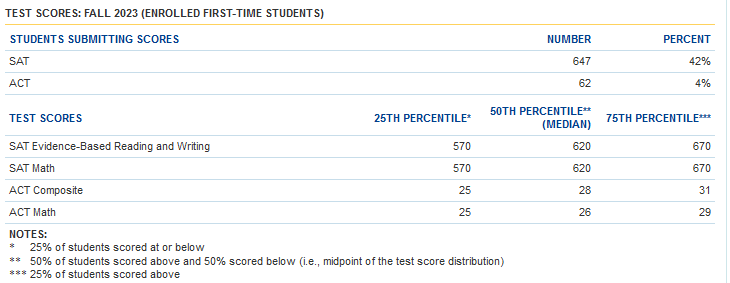I didn’t look up the average GPA, but I did look at TCNJ’s test distribution. As less than half of students submitted a test and her SAT would be in the top 50th percentile of those submitted, I made my guess and kept her chance as the same as for admissions.
(
source
Nobody here is saying you can’t handle the rigor of a “top” school. You may also be underestimating the rigor that can be found at a number of the schools I listed. Their admissions rates may not be as low as an Ivy or Johns Hopkins, but that doesn’t mean they don’t have amazing students, dedicated professors, and a quality education.
If you have an upward trajectory in your grades, a lot of schools will note that. Additionally, a comment from your school counselor about your sophomore year may help. And note that none of the categories labeled above were “Impossible”. It was just my guess as to your odds of getting in, not whether you’d be able to thrive at the institution.
I read some advice that was directed to parents who were selecting a school for their kids (K-12). In many areas of the country, families are only willing to send their kids to the top-rated schools, certain that schools that don’t have a high rating won’t be good enough for their kids. That means that there are schools that end up very segregated, both racially and socioeconomically. An organization had a pledge that asked families to visit at least two schools that they would normally have written off and to come up with at least two positive things about them and to share that with at least two others, in order to help change the narrative about the “not-good-enough” schools.
When parents ended up touring the schools, they were frequently very pleasantly surprised by what they saw actually going on in the schools. Because the schools didn’t have a certain cachet they had formed mental images about what the schools were like, but the reality ofen didn’t match those mental images. This wasn’t universally true, but it was often true.
The job for EVERY applicant in the college search is to find those schools that are extremely likely admits, extremely likely to be affordable, and where one would be happy to attend for four years. Oftentimes, that means that students might need to find the hidden gems that don’t get the same levels of attention as the Big Names. Just because it’s not a Big Name does not mean that it’s not a good school.
So when you are looking for your sure thing schools, look at their special programs, or what the application process is for the honors program and what that looks like. Look at their residential learning communities or interesting clubs or faculty whose research looks interesting that you might be able to work with. Maybe it’s the ability to intern for lobbyists or state legislators, or maybe it’s the attention and opportunities given to students they think might be good candidates for postgraduate fellowships like Rhodes or Fulbrights. And, sure things are likely to be among the most generous in doling out merit aid, because you’re likely in the top 25% of their applicant pool, meaning that they may be more likely to fit into the budget and/or to leave extra money for graduate school or a down payment on a house, or something else.
And then in the spring of your senior year, you’ll look at your options. Maybe you’ll have some acceptances from a low probability (or very low probability) school. You will hopefully have acceptances from extremely likely schools and probably likely schools as well. And you can see where the best fit for you will be. It might be a low probability school, but it could be an extremely likely admit. The odds of admission does not necessarily correlate to how great of a fit the school will be for you.

